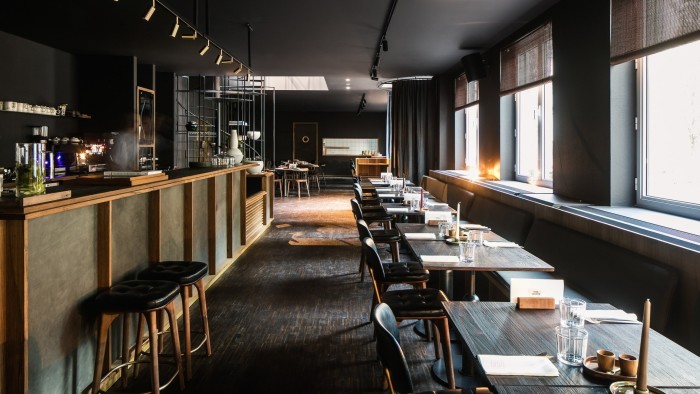Unlock the Editor’s Digest for free
Roula Khalaf, Editor of the FT, selects her favourite stories in this weekly newsletter.
On the lower floor of what looks like a bland Brussels shopping mall is an anonymous-looking sign for something called The White. The entrance resembles the facade of a rundown print shop. From the outside few would assume that anything interesting was going on here. They certainly wouldn’t expect this to be one of the go-to spots for EU officials.
Yet in Brussels, some of the best loved, most frequented places to meet are tucked away in unexpected and unconventional locations. For insiders, this is a quintessential aspect of the city’s charms. It is a place that rewards the curious and the persistent.
Take The White. Its unpromising location next to a busy road and the glass Madou Plaza Tower skyscraper has no bearing on the interior. Once inside, the Scandinavian noir-style establishment feels like a retreat. The noise of sirens from the street outside is replaced by the hum of conspiratorial chatter.
Discoveries like this are one of the ways in which Brussels feels so different from other global cities. In places like London, Paris and New York, good spots tend to be abundant and obvious. Here there is little point wandering the streets looking for the most appealing exteriors — you have to know in advance where you’re going. Even then it is easy to get lost.
The city’s abundance of luxury hidden within mundane buildings has a back-story. Before it was the beating heart of European policymaking, Brussels was a midsize, medieval Belgian city. Following second world war reconstruction it underwent rapid modernisation, leading to the destruction of historic sites and the construction of often ugly new buildings alongside vast roads.
After that, the establishment of the European Commission and associated sprawling institutions resulted in a sudden influx of EU officials from member states. Their arrival meant the city was badly in need of decent places to have a meal. But the new establishments that sprang up had to be tucked inside existing, often uninspiring infrastructure.
Busy roads and featureless blocks can make it hard to know where these locations are. Though you can sometimes guess by knowing which offices are nearby.
The White restaurant, for example, is close to the EU’s powerful competition unit, a group that favours quiet, discreet meeting places.
One of the city’s most popular spots is Dal Padrino, which sits just steps from the Berlaymont building — the headquarters of the European Commission built on the grounds of a former convent. Dal Padrino exemplifies the hidden gems within Brussels. Walk too quickly along the street and you are likely to miss its dated sign. The dull exterior gives no hint of the restaurant’s cosy interior and quality food.
This has been the location for many crucial meetings over the years. Cecilio Madero, a former senior EU official, recalls when his team at the European Commission met their Washington counterparts at Dal Padrino during the EU’s antitrust investigation of Microsoft in 2004. “It’s one of those places you need to be in the know to go,” says Madero. “Otherwise it’s not an obvious lunch spot.”
Newcomers to Brussels must rely on those who have lived in the city for a while if they want to find their way to the places that insiders favour. A friend I have known since my early days here declares that she is about to leave the city after a decade and wants to host a farewell meal. We pick Comme chez Soi, a Brussels institution run by five generations of the same family. As is often the case, finding the spot proves tricky.
To reach the restaurant, I navigate one of the main train stations, Midi, where the smell of neglect hangs in the air, and cycle past a huge construction site, clearing the way for a new metro line. Despite careful instructions I still manage to miss the restaurant’s door, ending up across the street.
Once I find my way inside, I realise that my friend and I are the only non-Belgians in the room. Brussels may be a global political centre but it is a city that still caters best to its residents. As my friend puts it, to live here “you have to remove a bit of litter, go through something ugly and earn your place”.
javier.espinoza@ft.com
Read the full article here

